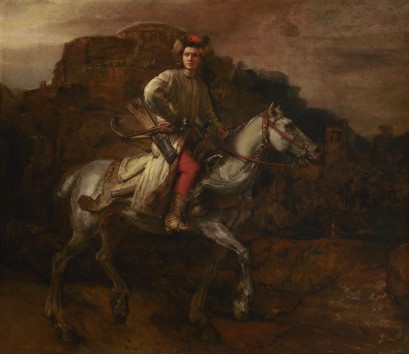

One of Rembrandt’s most recognizable works and only one of two known equestrian portraits by the Dutch master. ‘The Polish Rider’, once in the collection of King Stanisław August and now in The Frick Collection in New York, will be on display in the Picture Gallery in the Palace on the Isle from 6 May to 7 August 2022.
The exhibition will be open on Tuesday, Wednesday and Sunday from 10.00 to 16.00 and on Thursday, Friday and Saturday from 10.00 to 18.00.
‘The Polish Rider’ – history of the work
The ‘The Polish Rider’ was painted around 1655. Rembrandt’s authorship has been confirmed by researchers from the Rembrandt Research Project and at present doesn’t raise any doubts. The work illustrates the Dutch painter’s masterful, mature style and is one of only two known equestrian portraits in his oeuvre. However, it is not known to this day who ‘The Polish Rider’, also called Lisowczyk, represents – a soldier of a specific formation (Lisowczyks), an Old Testament or literary hero or a specific character.
The mystery of the painting and its extraordinary, poetic mood, as well as its purely painterly qualities – the masterly technique of brushstrokes and refined colour tonality, typical of Rembrandt – determined the extraordinary popularity of the work.
In 1791, the painting of the Dutch painter was offered to Stanisław August by Michał Kazimierz Ogiński, Grand Hetman of Lithuania, in exchange for orange trees from the royal gardens. At the time, the monarch, a great admirer of Rembrandt’s art, had eleven paintings considered to be the master’s works (in fact, there were no more than three originals). ‘The Polish Rider’ hangs in the Hall on the first floor of the Palace on the Isle in the Royal Łazienki, the beloved summer residence of the monarch, where the king gathered the most valuable works of his painting collection. After the king abdicated in 1795 and left the country, the painting remained in Łazienki. Towards the end of the 1790s, the painting was moved to the Picture Gallery on the ground floor of the Palace, where it will now be presented to the public.
Since the death of Stanisław August, his heirs have gradually sold off the royal collection and, after 1814, ‘The Polish Rider’ found its way into collections of successive art lovers. In 1910, Zdzislaw Tarnowski, the then owner of the painting decided to sell his already famous Rembrandt, which had gained in value enormously. The work was bought by the American financier, industrialist, art patron and collector, Henry Clay Frick. ‘The Polish Rider’ is on display in the magnificent interiors of his New York residence on Fifth Avenue in Manhattan – among the works by Bellini, Vermeer, Goya and Fragonard. After Frick’s death, his family residence was converted into a museum. Today, The Frick Collection is considered one of New York’s most important cultural institutions. The exceptional circumstances surrounding the relocation of the Frick collection to a temporary building for the duration of the renovation of the historic residence created an opportunity for a visit of ‘The Polish Rider’ to the Royal Łazienki, more than two hundred years after the masterpiece had left the residence of the last Polish king.
‘The Polish Rider’ by Rembrandt – accompanying events
The exhibition ‘The King’s Rembrandt. The Polish Rider from The Frick Collection in New York’ will be accompanied by a publication in the Polish and English language featuring essays by the curators of the exhibition. Moreover, lectures on the art of Rembrandt and the collection of Stanisław August will also be offered, with the participation of highly regarded painting curators, including Dr Xavier Salomon, Deputy Director of The Frick Collection, and Professor Antoni Ziemba. A family painting zone will open in the Old Guardhouse.
Exhibition partners: The Royal Łazienki Museum in Warsaw and The Frick Collection in New York
Curators: Xavier Salomon, Izabela Zychowicz, Dorota Juszczak
Partners: Wawel Royal Castle – State Art Collections, Royal Talens
Media patrons: Warsaw Insider, Mówią Wieki, PAP, Kultura wokół Nas, Wernisażeria, TVP Kultura, TVP Historia, RDC, Niezła Sztuka, Karmione Kulturą
Patrons of the Museum: PZU
The exhibition was co-financed by the Minister of Culture and National Heritage.